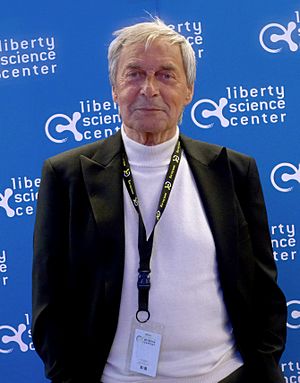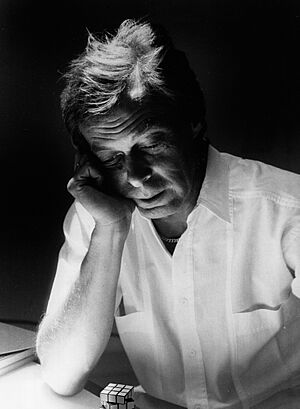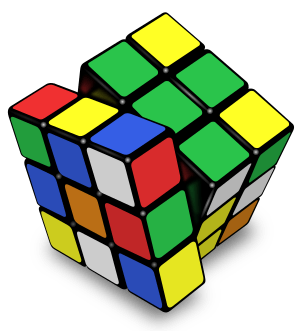Ernő Rubik facts for kids
Quick facts for kids
Ernő Rubik
|
|
|---|---|

Rubik in 2014
|
|
| Born | 13 July 1944 Budapest, Hungary
|
| Education |
|
| Occupation | Inventor, designer, businessman |
| Years active | 1971−present |
| Employer | Rubik Brand Ltd. (U.S.) |
| Known for | Puzzle designer of Rubik's Cube, inventor, architect, professor |
| Title | Chairman |
| Board member of | Judit Polgar Foundation |
| Spouse(s) | Ágnes Hégely |
| Parent(s) | Ernő Rubik, Magdolna Szántó |
Ernő Rubik, born on July 13, 1944, is a famous Hungarian inventor and architect. He is best known for creating the Rubik's Cube in 1974. He also invented other popular puzzles like Rubik's Magic and Rubik's Snake.
Even though Rubik is famous for his puzzles, he now spends a lot of time promoting science education. He works with groups like Beyond Rubik's Cube and the Rubik Learning Initiative. These groups help young students get excited about science, math, and solving problems.
Rubik studied art and architecture in Budapest, Hungary. While he was a professor, he enjoyed building geometric models as a hobby. One of these models was an early version of his famous cube. It took him a month to figure out how to solve his own puzzle! The cube became a great tool for teaching math. In 1977, a Hungarian company started selling it. By 1980, the Rubik's Cube was sold all over the world. Over 100 million official cubes were sold, plus many copies. Many books were written to help people solve the puzzle. After the cube became popular, Rubik opened a studio in 1984 to create new designs. One of his new inventions was another popular toy, Rubik's Magic.
Contents
Early Life and Education
Ernő Rubik was born in Budapest, Hungary, on July 13, 1944. He has lived in Hungary his whole life. His father, also named Ernő Rubik, was an engineer who designed airplanes. His mother, Magdolna Szántó, was a poet. Ernő Rubik has often said that his father was a big inspiration for him.
His father was a respected engineer who designed gliders. He was known around the world for his skill in this area. Ernő Rubik learned a lot from his father about hard work and finishing projects. He said his father could "move a hill" if he wanted to.
From 1958 to 1962, Rubik studied sculpture. Then, from 1962 to 1967, he went to the Budapest University of Technology to study architecture. After that, from 1967 to 1971, he studied interior design at the Hungarian Academy of Applied Arts and Design.
Rubik believes that his university education was very important in shaping his life. He said that schools helped him learn skills that need a lot of practice and hard work, with guidance from teachers.
Creating the Rubik's Cube
From 1971 to 1979, Rubik taught architecture at the Budapest College of Applied Arts. During this time, he created designs for a three-dimensional puzzle. He finished the first working model of the Rubik's Cube in 1974. He applied for a patent for his puzzle in 1975. In an interview, Rubik said he was looking for a good project for his students.
He was always interested in space and how objects change it. He thought about how sculptures and designs transform in space and time. He felt the Cube came from this interest and his desire to express these ideas.
Rubik started with wooden blocks and rubber bands. He wanted to make a structure where the pieces could move without falling apart. He used wood because it was easy to work with in the university workshop. He made the first cubes by hand, cutting the wood and using elastic bands to hold them together.
Rubik showed his new puzzle to his students, and they loved it. He realized that the cube's simple design meant it could be made easily. He thought it might be popular with many people. Rubik's father had several patents, so Rubik knew how to get one for his invention.
He then looked for a company in Hungary to make the cube. This was hard because Hungary had a strict planned economy at the time. Finally, he found a small company that made plastic chess pieces. The puzzle was first called the Magic Cube in Hungary.
In 1979, Rubik allowed an American company called Ideal Toys to sell the Magic Cube. Ideal Toys changed the name to the Rubik's Cube. It was introduced to the world in 1980. It took over six years from the first model to mass production. The Rubik's Cube quickly became a huge success worldwide. It won many "Toy of the Year" awards. It became a very popular part of the 1980s. So far, over 350 million Rubik's Cubes have been sold. This makes it one of the best-selling toys ever.
Other Inventions and Later Work
Besides the Rubik's Cube, Ernő Rubik also invented other puzzles. These include Rubik's Magic, Rubik's Snake, and Rubik's 360.
In the early 1980s, he became the editor of a puzzle magazine called ...And games. In 1983, he started his own company, Rubik Stúdió. There, he designed furniture and games. In 1990, he became the president of the Hungarian Engineering Academy. At the academy, he created the International Rubik Foundation. This foundation helps talented young engineers and designers.
Rubik attended the 2007 World Speedcubing Championship in Budapest. He also gave a speech and signed autographs at a conference in 2010. In 2009, he became an honorary professor at Keimyung University in South Korea.
In recent years, Rubik has spent a lot of time on Beyond Rubik's Cube. This is an exhibition about Science, Technology, Engineering, and Math (STEM fields). The exhibit travels around the world. It opened on April 26, 2014, at the Liberty Science Center in New Jersey. At the opening, Rubik gave talks and met with the public. He also met with speedcubing champions.
Rubik is also on the advisory board for the USA Science and Engineering Festival. In December 2024, Rubik was interviewed on the educational math channel Numberphile.
Influences and Interests
Ernő Rubik has mentioned several people who greatly influenced him through their work. These include Leonardo da Vinci, whom he sees as a true "Renaissance man." He also admires Michelangelo, a painter and sculptor, and artist M. C. Escher, who drew amazing impossible shapes.
For philosophers and writers, Rubik likes Voltaire, Stendhal, Thomas Mann, Jean-Paul Sartre, Hungarian poet Attila József, Jules Verne, and Isaac Asimov. In architecture, he admires Frank Lloyd Wright and Le Corbusier.
Rubik says he loves books and has read them his whole life. He says books helped him learn about the world, nature, and people. He especially enjoys science fiction. He also likes nature walks, sports, and sailing on Lake Balaton. Gardening, especially collecting succulents, is his favorite hobby.
Prizes and Awards
- 1978 – Budapest International Trade Fair, Prize for the Cube
- 1980 – Toy of the Year: Federal Republic of Germany, United Kingdom, France, USA
- 1981 – Toy of the Year: Finland, Sweden, Italy
- 1982 – Toy of the Year: United Kingdom (second time)
- 1982 – The Museum of Modern Art, New York selected Rubik's Cube into its permanent collection
- 1983 – Hungarian State Prize for showing and teaching 3D structures and for inspiring scientific research
- 1988 – Juvenile Prize from the State Office of Youth and Sport
- 1995 – Dénes Gabor Prize for achievements in innovation
- 1996 – Ányos Jedlik Prize from the Hungarian Patent Office
- 1997 – Prize for the Reputation of Hungary
- 2007 – Kossuth Prize (Hungary's most important cultural award)
- 2008 – Moholy-Nagy Prize – from the Moholy-Nagy University of Arts and Design
- 2009 – EU Ambassador of the Year of Creativity and Innovation
- 2010 – USA Science and Engineering Festival Award (Outstanding Contribution to Science Education)
- 2014 – Hungarian Order of Saint Stephen (The highest Hungarian state honor)
- 2014 – Honorary Citizen of Budapest
See also
 In Spanish: Ernő Rubik para niños
In Spanish: Ernő Rubik para niños



